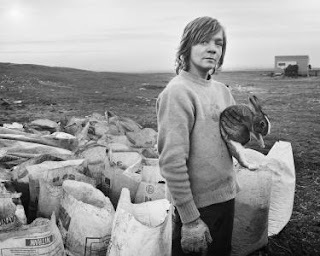 |
| The Photographer's Gallery, Ramillies St, London W1 |
I have always loved the exhibition of the work of artists
competing in the Deutsche Börse Photography Prize. Even though my choice of
winner and the prize winner rarely coincide, the exhibition has
always included very worthy contenders. This, together with the new home of the
Photographer’s Gallery in Ramillies street, made the visit to the Deutsche
Börse Photography Prize for 2013, a delight. The new gallery is a converted warehouse that more resembles a New
York gallery than a London space. It is filled with an openness and light coming in
the glass wall on the two upper floors overlooking the buildings below. The viewing conditions are
ideal.
 |
| Chris Killip, Boo and His Rabbit Lynemouth, 1983 |
The four photographers in the 2013 competition are all so
different in their concerns, but yet, connect in their focus on the social
margins and the marginalized. Chris Killip’s What Happened – Great Britain, 1970-90 is the only body of work
included in this year’s that resembles traditional C-print photography.
Killip’s spare, beautifully composed black and white images of the working
class, of children, old people, the poor in the north of England sits squarely
within a British Realist tradition. Killip’s photographs are, without a doubt,
the most aesthetically pleasing, but it has to be said, he does not explore new
possibilities with the medium. His photographs are classically composed,
beautifully lit images that show the despair of a post-industrial land. That
said, while they do not pose formal challenges, the works are important for
their evocation of the silence and desolation of a world that has been
forgotten by the nation. Britain still needs to see this narrative.
 |
| Mishka Henner, Contrada Vallecupa, Colonnella, Abruzzi, Italy, 2011 |
Mishka Henner’s photographs, video images and digital printouts
for No Man’s Land (2012) get my vote
for the prize. What’s interesting about Henner’s works is their topicality,
their complex engagement with political discourses on gender, on sex workers,
on the politics of the production of images and visuality, on the European
Union and its growing austerity measures. The politics of Henner’s works are at
the forefront of issues being grappled with at all levels of European culture
and policy making. Henner’s images in both still and moving form are created
through Google Street View at locations that he found through on-line forums
used by men to find sex workers on the outskirts of major cities in southern
European. Thus the multiple discourses of mapping, travelling, marginal
cultures and peoples, sex work, voyeurism, and others, merge in what are not
always aesthetically alluring images. But as we look at prints of Google Street
view, we are forced to think about the politics of the images. When we look at
Killip’s lovely c-prints, it’s easy to get distracted by the beauty of the
carefully composed images, but with Henner’s images there is nowhere else to
look: we are forced to look the degredation and unsettling representations in
the eye. At the same time as what might be called Henner’s anti-aesthetic is
difficult to look at, it is also striking because it is the mode of image
information to which we are becoming more and more used. By exhibiting our
accustomed form of image consumption in the eye, but through a different
perspective, on the walls of a gallery, we are unsettled.
 |
| Adam Broomberg & Oliver Chanarin, Plate 23, 2011 |
The other installation I found interesting is Adam Broomberg
and Oliver Chanarin’s War Primer 2,
2012. Broomberg and Chanarin have created a book which does not simply
reappropriate Bertolt Brecht’s photo-essay War
Primer (1955). They google search what Brecht calls the “photo-epigrams”
that accompany images of WWII destruction from 1955, and paste the resulting
images over those of Brecht’s original. The result is a conversation between
the destruction resulting from Nazi Germany and that of the “war on terror.” On
the one hand, we could argue that bodies falling out of the World Trade Center
on fire pasted over destroyed Dresden, is a dialogue between the two images. On
the other hand, we could just as convincingly argue for an equation between the
two wars. If the latter is the chosen interpretation, then Broomberg and
Chanarin’s exhibition is distressing. However, as we look closer, we also
recognize that the equation between the destruction of WWII and that of the
“war on terror” is an equation established by the internet, as it is an
equation borne of the google searches. In turn, this realization then reflects
on the deeply damaging effects of the media that document these and other
events.
Indeed, time spent with this installation reveal that there
are still more dialogues taking place here. The uncanny relevance of the texts
that Brecht pasted under his images to the contemporary war on terror , is
frightening. Because through the results of the google searches of Brecht’s
texts, a question emerges: who is the terrorizer in the “war on terror”? Is it
Osama Bin Laden and the Taliban? Or is it the American government? This is the
real conversation or dialogue that then gets set up, where one “organization”
is as destructive as the other. Again, while Henner’s images engage in a very
troubling sense of our own culpability in the oppression through visualization
of those on the margins, Broomberg and Chanarin’s installation slowly uncovers deep
ambiguities that disturb in a different way. To my mind, this is the role of
contemporary art. Nevertheless, forced to choose between the two, Henner gets
my vote because of its reach, its accessibility, and its topicality.
No comments:
Post a Comment